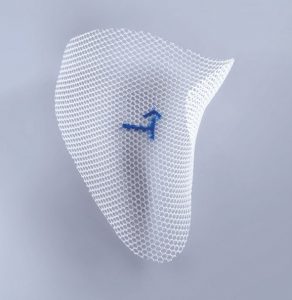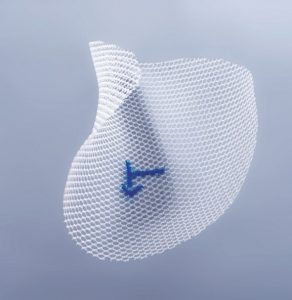Surgical mesh for inguinal hernia repair
|
right version |
left version |
|
|
Class IIB |
||
PRODUCT CHARACTERISTICS
Optomesh® 3D non-resorbable surgical mesh products are knitted of transparent and blue monofilament polypropylene yarn using the knitting technique. They are designed for use in inguinal hernias.
The product is offered in the following variants:
- right side, size S/M
- right side, size L
- left side, size S/M
- left side, size L
Optomesh® 3D products do not contain substances of allogenic and animal origin. Optomesh® 3D products have a marker that facilitates mesh implantation. The marker is made of blue monofilament polypropylene yarn.
INDICATIONS
Optomesh® 3D surgical meshes are recommended for reconstructive procedures in order to supplement and/or strengthen the defects of soft tissues in the case of inguinal hernias, both primary and recurrent.
Depending on the type of hernia and the surgical method used, the appropriate type of surgical mesh can be selected, taking into account the preferences of the surgeon, the nature of the reconstruction and the applicable medical standards.
CONTRAINDICATIONS
Optomesh® 3D should not be used in infected wounds or susceptible to infection and in conditions where it is not possible to maintain strict surgical asepsis. The Optomesh® 3D product is also not recommended in the case of the patient’s allergy/sensitivity to the product material (polypropylene).
Optomesh® 3D should not be used in children, women planning pregnancy, pregnant women, and where the process of physiological growth restricts the use of mesh products.
It is not recommended to implant Optomesh® 3D in direct contact with internal organs due to the possibility of causing adhesions, fistulas or intestinal obstruction. Do not use the product if there is doubt about its sterility (e.g. soaking, cracked/damaged unit packaging, product discolouration).
PRECAUTIONS
- Optomesh® 3D is designed for use by qualified and trained medical personnel.
- In order to ensure strict surgical asepsis during the procedure, it is advisable to use special precautions (use of personal protective equipment, sterilisation of instruments, keeping high personal hygiene) and extraordinary attention while preparing the direct intervention site of the surgeon.
- Optomesh® 3D should only be used in non-infected wounds, and in conditions where it is possible to maintain strict surgical asepsis.
- Avoid direct contact of the mesh with internal organs.
- Do not implant the Optomesh® 3D surgical meshes after the expiration date.
- Optomesh® 3D polypropylene surgical meshes are offered for sale only in a sterile version. The product cannot be re-sterilised.
- Product for single use only.
- Do not use the product if it is damaged, with structural defects or contaminated.
FIXATION
The Optomesh® 3D mesh can be used without fixation, while the final decision on the possibility and type of fixation rests with the specialist doctor who performs the procedure. If an implant fixation is needed, surgical sutures, tackers (surgical screw-like tacks), tissue adhesive or staplers (surgical staples) is recommended. Absorbable fixing materials are also allowed. The size of the mesh and distance between the fixing places should be selected according to the surgeon’s preferences, the nature of reconstruction and medical standards. It is allowed to cut the implant during a surgery to fit into the cavity. Using the fasteners the implant should be placed to closely adhere to the adjacent tissue. In order to prevent the recurrence of hernia, it is recommended to place the fixing elements at least approx. 1 cm from the edge of the product.
POSSIBLE COMPLICATIONS
The use of the product may cause the following complications: exudation of blood and serous fluid, infections, pain, discomfort in the wound, haematomas, bruises, recurrence of hernia, intestinal growth, formation of fistulas, adhesions, intestinal obstruction. Diagnosed postoperative wound infections should be treated as soon as possible using available pharmacological methods. If severe and chronic infection is found, the possibility of partial resection of the infected tissue and/or the mesh should be considered. If no progress is made in the treatment of the infection, the need for complete removal of the implant should be considered. The use of surgical tackers and staplers can cause chronic pain due to compression of the nerves. These complications may cause a prolonged treatment process, chronic pain, recurrence of hernia, repeated surgical intervention or, in extreme cases, removal of the implant. The use of a non sterile, damaged device and its re-use may result in the above-mentioned complications or serious damage to the health and life of the patient.
STERILISATION PROCESS
Sterilisation is carried out by means of ethylene oxide (EO) in a validated process.
The product maintains its sterility within a specified validity period, kept only in the original packaging at maintaining appropriate storage conditions.
STORAGE CONDITIONS
Optomesh® 3D should be stored:
- in dark rooms at humidity 25-65%,
- at temperature range 15–35oC,
- under conditions eliminating wetting and mechanical damage or chemical contamination,
- in the original unit packaging (box and direct packaging). Any mechanical damages to the packaging can expose the product to the loss of sterility.




